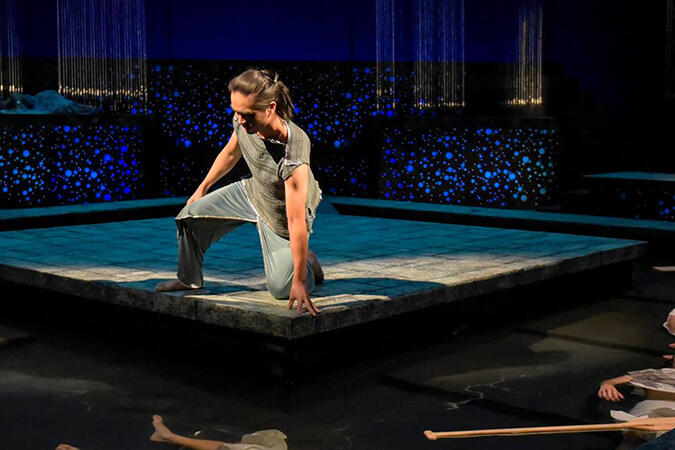Jack Carpenter, continuing lecturer for lighting design, has retired from TDPS after eight years.
"I want to thank all of my lighting design students, the crews, stage managers, creative teams, and performers for the productions over the past eight years," Jack said. "You all have made my time at TDPS exciting and memorable. I especially want to thank Eugene Palmer, who makes every production not only possible, but oh so enjoyable."
Jack joined TDPS in 2013 with 35 years of experience as a lighting designer and production manager for dance, music, theater, museum exhibits, and opera. His work has been shown by the Bishop Museum, Oakland Museum, Exploratorium, SF Ballet, SF Symphony, Kronos Quartet, Berkeley Repertory Theatre, Joe Goode Performance Group, ODC/SF, Project Bandaloop, Eureka Theatre, and others. He has received four Bay Area Critics Circle Awards and five Isadora Duncan Awards. He graduated from Grinnell College with degrees in history and theater.
Read a Q&A with Jack below.
Which TDPS productions were the most rewarding or memorable from your perspective as a lighting designer?
Oh, so many to choose from... I loved working with Chris Herold. He has the perfect balance of a clear vision with openness to different ideas and direction. Certainly on the list would have to be Metamorphoses (2017). The ongoing challenges of the big pool of water and the beautiful staging on the gorgeous set by Nina Ball, gave me endless visual compositions. I also loved working on 70 Scenes of Halloween (2018) and Summertime (2014), both directed by Chris. I enjoyed collaborating with Annie Smart and lighting her environments for Tartuffe (2018) and The Caucasian Chalk Circle (2019). Lighting dance has always been my first love. I will always cherish working with Lisa Wymore, Jo Krieter, Katie Faulkner, and Latanya Tigner on Berkeley Dance Project and Joe Goode on The Re-Entry Project.
The true joy of working for TDPS was in mentoring the student designers. Some of my most rewarding memories came from watching the young designers develop their own aesthetic and tackle the design challenges of the fall choreography showcase and the student-directed one acts. I especially want to mention Dylan Feldman, Hayden Kirschbaum, Ryann Hirt, Milania Cardona, Tiffany Hernandez, Seth Lu, Tai In Chung, and Eva Hu as students that had a particular passion and inventiveness to their work.
Have there been any notable changes in your work during your time with TDPS?
When I first started, I was teaching in Zellerbach Room 130. It was small, cramped, and had no easy way to display lighting fixtures, control systems, or color mixing with modern instruments. Lisa Wymore (department chair at the time) had been gradually outfitting Zellerbach 170 as a dance/technology interactive space. Wil Leggett (production manager at the time) found some funds to finish a long dreamed of plan to install a small lighting system in Zellerbach 170 for student workshop performances and showings. I asked if I could begin teaching in that space, which allowed me to transition my teaching from pure lecture, to a symbiosis of theory and practice. We would explore a topic, such as additive color mixing, and then look at adding layers of color to a surface to produce a third color. This also allowed the students to work on small projects writing cues into the controller to create visual narratives, shifting visual focus from one subject to another. The level of engagement with the students went up dramatically. You could feel the "aha" moments as the students began to viscerally understand the interaction of theory and practice.
Are there any lessons or insights you'll take away from your time working with TDPS students?
About a third of the assignments for the lighting design class concerned observing light. Describing a sunset, narrating a night walk in Berkeley, or observing the lighting in a performance. As a way of motivating the conversations in class, I would also do the assignment and describe to the class what I saw. I am currently living in the Sierra Foothills in a less urban, more forested environment. I still spend a good deal of time looking at, say, a sunset, and recall the principles of light that occur, and how they might translate to techniques we would use in the theater; translucency, refraction, color contrast, fade times, etc. I still find myself observing natural lighting, and mentally describing the phenomenon, and even thinking of ways to better correlate the natural occurrences with theatrical practice.
Do you have any advice for anyone who's interested in pursuing work in lighting design or scenic design?
Even though this is not the path I took, I would highly recommend that any students who are seriously considering a career in lighting or scenic design should attend a good graduate program. Times are different now than when I was in college. The field is much fuller and more competitive. In lighting, the equipment is far more complex (control, smart fixtures, LED technology, CAD programs). Even in the smallest, scrappiest venues now, the lighting gear is more advanced and requires a more comprehensive understanding of how to achieve your vision. Theatre has gotten very expensive, and, thus, time in the theatre to program and rehearse ever more valuable and pricey. Within our current students' lifetimes, the use of visualization tools will become increasingly required.


